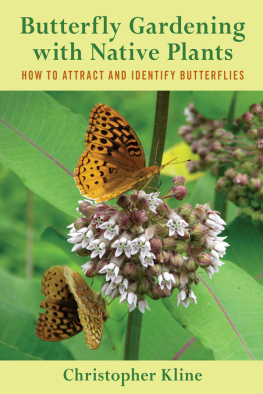Contents
Guide
Dedicated to the memory of
my mother, who taught me
the true spirit of gardening
This project was made possible in part by a generous grant from the Stanley Smith Horticultural Trust.
2016 by Barbara Eisenstein
All rights reserved. No portion of this work may be reproduced or transmitted in any form or by any means, electronic or mechanical, including photocopying and recording, or by any information storage or retrieval system, without permission in writing from Heyday.
Library of Congress Cataloging-in-Publication Data
Names: Eisenstein, Barbara, author.
Title: Wild suburbia : learning to garden with native plants / Barbara Eisenstein.
Other titles: Learning to garden with native plants
Description: Berkeley, CA : Heyday, [2016]
Identifiers: LCCN 2016001540 | ISBN 9781597143639 (pbk. : alk. paper)
Subjects: LCSH: Native plant gardening--California. | Endemic plantsCalifornia.
Classification: LCC SB439.24.C2 E37 2016 | DDC 635.9/67609794dc23
LC record available at http://lccn.loc.gov/2016001540
Cover Art: Barbara Eisenstein
Cover Design: Ashley Ingram
Photos: All photos, except those on , by Barbara Eisenstein
Interior Design/Typesetting: Leigh McLellan Design
Orders, inquiries, and correspondence should be addressed to:
Heyday
P.O. Box 9145, Berkeley, CA 94709
(510) 549-3564, Fax (510) 549-1889
www.heydaybooks.com
10 9 8 7 6 5 4 3 2 1
CONTENTS
PREFACE
I F YOUVE PICKED up this book, presumably you are curious about gardening with native plants. Perhaps you admire your neighbors garden with its colorful California poppies and spicy-scented sages. Perhaps you are looking to be more drought conscious and save on your water bill by transforming your green lawn into a landscape better suited to Californias dry climate. Perhaps you share scientists growing concerns about endemic wildlife and want to do your part to offer refuge to the bustling birds, butterflies, bees, and lizards in your community. Perhaps you are uneasy about the poisons and pesticides that go into green lawns and nonnative gardens and want to be more in tune with the natural landscape and its seasons, rhythms, and native species. Perhaps you already know a bit and want to learn more.
In all of these cases, this book is for you! And if you need more convincing about the advantages of gardening with native species, you will find plenty in the pages that follow. There are many good books on the market about native gardening in California, but when I first undertook my own California native garden, I couldnt find one that addressed the beginning native gardener, offered a personal perspective, emphasized the transition from green lawn to native garden (and whats required for its ongoing maintenance), and shared common pitfalls. This is my attempt to fill that gap.
For me the journey to this wild suburbia began in a new house, in a new part of the country. Moving from the East Coast to the West, I felt disoriented and homesick. I missed the lush green summers, vibrant fall foliage, and the rejuvenating spring flowers, if not the cold winters. I wanted to feel at home in hot, dry Southern California. I wanted to understand the seasons that were barely noticeable in their subtlety.
It was through gardening that I learned to appreciate and love a world of brown and gray, where rain, if it comes at all, is sparse and sequestered into less than half the year. The unusual pattern of winter rains and dry summer heat that gives us subdued colors through much of the year is also responsible for the spectacular burst of color during our spring wildflower season. I still miss the lush green of the East Coast, but I have come to understand and love our own seasons and the remarkable ways that plants and animals have adapted to life here. Wherever you live, you too can feel more at home if you understand and accept the natural conditions around you.
Join me on this journey from an artificial and controlled suburbia to a wild and fun landscape just outside the door. Although the Mediterranean climate of coastal California requires gardening practices that differ from those used in most of the rest of the world, the general concepts presented here apply wherever you put trowel to soil.
This book is divided into six sections: Before You Start, Get to Know Your Yard, Formulate Your Plan, Learn about Native Plants, Create Your Garden, and Keep Your Garden Alive. Within each section, I include stories of my own wild suburbia and share practical information on habitat gardening with native plants. In an effort to make the book helpful to both novices and expert gardeners, I use common names for plants in the text. At the end of the book you will find plants listed with both their common and botanical names. (See Resources, .)
Much of what I know about gardening with native plants comes from my work at Rancho Santa Ana Botanic Garden, the largest botanical garden dedicated to California native plants. With a heightened awareness of the need to conserve water, the garden acquired funding from the Metropolitan Water District of Southern California (MWD) to develop a program to facilitate the successful use of water-wise native plants in residential and public gardens. The campaign disseminated information through a dedicated telephone hotline, e-mails, the gardens website, publications, community-education classes, and other outreach venues. Running this program gave me access to excellent questions from gardeners near and far, as well as reliable answers from my knowledgeable colleagues at the garden.
At the same time, I also founded a community stewardship program in a local nature park. In 2004 a three-acre habitat park opened in South Pasadena, and in the following years, weeds threatened to overwhelm the native plantings. With city support, I started Friends of South Pasadena Nature Park, and for the past ten years, I have held monthly cleanups, park tours, planting parties, and other educational events. Volunteers including students, scouts, adults, and seniors have removed invasive weeds, planted natives, grown wildflowers, and nurtured the new additions. We have watched native plants survive under the harshest conditions, and tried many strategies to reduce the onslaught of nonnative, invasive weeds. A once degraded, weedy lot has gradually become a vibrant habitat of local sage scrub and woodland plants.
The information I learned during these efforts has also been put to the test in my own garden, where I have gradually replaced lawn and other water-thirsty, nonnative plants with more appropriate California natives. I have made plenty of mistakes, and I hope this book presents them honestly so others can learn from my errors.
I have learned much from these gardening experiences, but exchanging ideas with other gardeners, both professionals and hobbyists, has been the most informative. Not only is there much to share, but gardeners make good friends.
This book would not have been possible without the help, friendship, and support of many people. I would like to thank Ellen Mackey for introducing me to the wilds of Los Angeles when I first arrived on the West Coast. Our adventures while mapping vegetation along the Los Angeles River taught me much about my new home, its unfortunate present condition, and its great potential.












